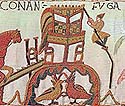![]() Textile
Production
Textile
Production
Textiles in Norman England were principally made from wool and linen, although silk was also available.


 The
first stage in wool textile production was combing which aligned the fibres so
that they could be spun into thread. Spinning required awooden spindle
weighted with a spindle-whorl. The thread was woven on one of two types of
loom. The first was a vertical loom with a beam at the top and bottom which
could be rotated to keep the warp (vertical) threads taut. This loom was
primarily used for weaving blankets, rugs and tapestries. More widely used was
the horizontal loom, driven by foot-powered treadles which allowed an
increased rate of production of both wool and linen textiles than was possible
hitherto.
The
first stage in wool textile production was combing which aligned the fibres so
that they could be spun into thread. Spinning required awooden spindle
weighted with a spindle-whorl. The thread was woven on one of two types of
loom. The first was a vertical loom with a beam at the top and bottom which
could be rotated to keep the warp (vertical) threads taut. This loom was
primarily used for weaving blankets, rugs and tapestries. More widely used was
the horizontal loom, driven by foot-powered treadles which allowed an
increased rate of production of both wool and linen textiles than was possible
hitherto.
Woollen cloth was often fulled which involved soaking and pounding it in troughs to shrink and thicken the fabric giving it a matted appearance. After fulling the cloth was stretched over a tenting frame to dry. The so-called 'nap' on the surface of the cloth was then raised using teasels and finally it was clipped to give a velvety finish. Cloth was coloured using vegetable dyes including woad (blue), madder (red), and greenweed (green and yellow).
 Linen
was made from flax and underwent a series of processes to separate the fibre
from the plant and prepare it for spinning and weaving. It was finished by
beating and smoothing to give it shiny finish.
Linen
was made from flax and underwent a series of processes to separate the fibre
from the plant and prepare it for spinning and weaving. It was finished by
beating and smoothing to give it shiny finish.
A variety of sewing techniques was used to make clothing and other items, but a specialised branch of needlework was embroidery. The most famous example is the Bayeux Tapestry which is made from coloured woollen thread embroidered on linen cloth. Celebrated also in Norman times was embroidery using gold thread which is found on furnishings, altar hangings and ecclesiastical garments.